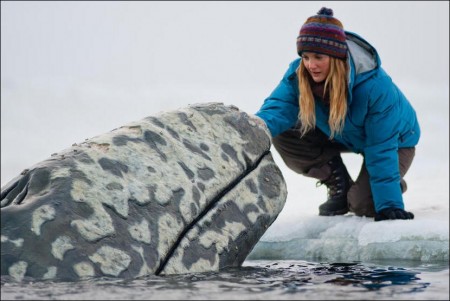Kwapis was an advocate for shooting in Alaska, a state that has not been used often in recent major filmmaking. With its newly minted incentive program in place, it could compete financially with better-known centers of production such as territories throughout Canada and the Pacific Northwest.
“Big Miracle is perhaps the only major studio film to shoot entirely in Alaska,” reflects Kwapis. “On many levels, we all felt we were exploring new territory. A filmmaker usually chooses a location for its physical beauty. I lobbied to shoot in Alaska for another reason: the people. It was odd to make the case to Universal that we needed to go to Alaska so that the extras looked right, but this was critical to the film’s credibility. The faces on screen had to be the right faces. You cannot find the Inuit people of Alaska anywhere but Alaska, and their faces form one of the film’s most beautiful landscapes.”
The director’s vision was shared by the production team, who backed the decision to base the filming in the bustling city of Anchorage. Offers Sugar: “What you gain by shooting in Alaska instead of inside a studio back lot is the feeling of being in another world. Ken very rightly advocated for Alaska, as well as the city of Anchorage, which turned out to be wonderful partners for us.”
While any production aims to be true to life, shooting in Barrow, hundreds of miles north of Anchorage, was not feasible. Anchorage, a modern city of 300,000 people located on the south central coast of Alaska, is in what locals term the “banana belt” for its comparatively mild temperatures. Explains Kwapis: “The town of Barrow could not accommodate a large shooting crew, so it was never an option. And of course, it is numbingly cold. Anchorage was our best choice.”
First on the agenda was finding a suitable spot to build the Barrow set in Anchorage, a city ringed by mountain ranges. Unfortunately, there were not many candidates, as there are very few places where one can look out on the horizon and not see mountains. After scouting one locale that was unobtainable and a second inaccessible to equipment, the team settled into an area adjacent to downtown Anchorage near the mudflats. This location gave them a partially unobstructed horizon with which to work.
That site, on railroad land just down a slope near downtown at the Port of Anchorage, gave the filmmakers not only space to build the Barrow ice field and portions of the town itself, but room for parking and equipment. “We needed an open view of the water, some place that had a clear horizon line,” says production designer Nelson Coates. “We also needed to have room to dig the breathing holes for the whales, which, for safety reasons, required the construction of a much larger surrounding hole.”
When the team commenced digging that hole, Coates and crew found something unexpected: debris from the 1964 Anchorage earthquake that had ravaged the city. “Apparently, the city had used this area for storing bulldozed remnants of the disaster in 1964,”says the designer. “We found things like mattresses, oil tanks, railroad ties and timber and had to be careful about where we dug.”
Related Link: Read the Full Production Notes for Big Miracle
Views: 377



